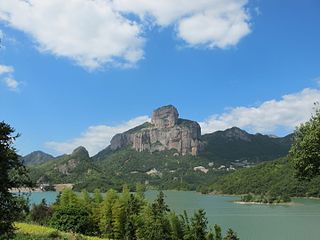
Zhejiang is an eastern, coastal province of the People's Republic of China. Its capital and largest city is Hangzhou, and other notable cities include Ningbo and Wenzhou. Zhejiang is bordered by Jiangsu and Shanghai to the north, Anhui to the northwest, Jiangxi to the west and Fujian to the south. To the east is the East China Sea, beyond which lies the Ryukyu Islands. The population of Zhejiang stands at 64.6 million, the 8th highest among China. It has been called 'the backbone of China' due to being a major driving force in the Chinese economy and being the birthplace of several notable persons, including the Chinese Nationalist leader Chiang Kai-shek and entrepreneur Jack Ma. Zhejiang consists of 90 counties.

Hangzhou, also romanized as Hangchow, is the capital and most populous city of Zhejiang, China. It is located in the northwestern part of the province, sitting at the head of Hangzhou Bay, which separates Shanghai and Ningbo. Hangzhou grew to prominence as the southern terminus of the Grand Canal and has been one of China's most renowned and prosperous cities for much of the last millennium. It is a major economic and e-commerce hub within China, and the second biggest city in Yangtze Delta after Shanghai. Hangzhou is classified as a sub-provincial city and forms the core of the Hangzhou metropolitan area, the fourth-largest in China after Guangzhou-Shenzhen Pearl River agglomeration, Shanghai-Suzhou-Wuxi-Changzhou conurbation and Beijing. As of 2019, the Hangzhou metropolitan area was estimated to produce a gross metropolitan product (nominal) of 3.2 trillion yuan, making it larger than the economy of Nigeria. As of the 2020 Chinese census, it had a total population of 11,936,010 inhabitants. However, its metropolitan area, populated by 13.035 million people over an area of 8,107.9 km2 (3,130.5 sq mi), consists of all urban districts in Hangzhou and 3 urban districts of the city of Shaoxing.
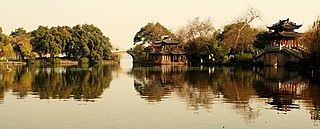
West Lake is a freshwater lake in Hangzhou, China. It is divided into five sections by three causeways. There are numerous temples, pagodas, gardens, and natural/artificial islands within the lake. Gushan (孤山) is the largest natural island and three artificial islands: Xiaoyingzhou (小瀛洲), Huixin Pavilion (湖心亭), and Ruan Gongdun (阮公墩) stand at the middle of the lake. Leifeng Pagoda (雷峰塔) and Baochu Pagoda (保俶塔) are separated by the lake. Mirroring each other, the basic pattern of "one mountain, two towers, three islands, three banks, and five lakes" is formed.
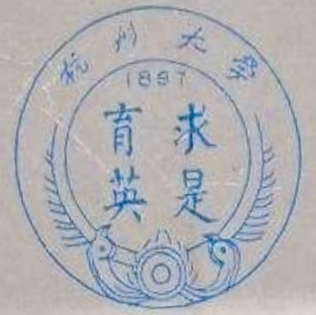
Hangzhou University, colloquially called Hangda and formerly romanised as Hangchow University, was a public university in Hangzhou, Zhejiang, China. The university was founded as Zhejiang Teachers College in 1952 by merging the departments of humanities, sciences and education at Hangchow University and Zhejiang University. The name of the university in postal romanisation is the same as Hangchow University run by American missionaries, yet the Chinese names are different.

Xiaoshan is one of ten urban districts of the prefecture-level city of Hangzhou, the capital of Zhejiang Province, East China. Xiaoshan was formerly a city in its own right, separated by the Qiantang River from Hangzhou proper, but the municipality was annexed by its more populous neighbor in 2001.

Cixi, alternately romanized as Tzeki, is a county-level city under the jurisdiction of the sub-provincial city of Ningbo, in the north of Zhejiang province, China. As of the 2020 census, its population was 1,829,488. Its urban agglomeration built-up area, largely contiguous with Cixi plus the county-level city of Yuyao, had 3,083,520 inhabitants.

Leifeng Pagoda is a five story tall tower with eight sides, located on Sunset Hill south of the West Lake in Hangzhou, Zhejiang, China. Originally constructed in the year AD 975, it collapsed in 1924 but was rebuilt in 2002. Since then, it has become a popular tourist attraction.
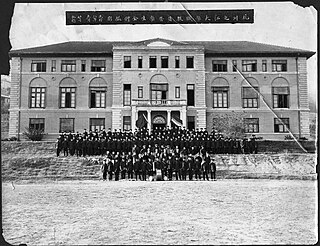
Hangchow University, also spelled as Zhijiang University and formerly known as Hangchow Christian College, Hangchow College and Hangchow Presbyterian College, is a defunct Protestant missionary university in China, which is one of the predecessors of Zhejiang University. Founded as Ningpo Boy’s Boarding School by Divie Bethune McCartee and colleagues of Northern Presbyterian Church in Ningbo in 1845, the university was one of the oldest missionary schools in China before it was shut down in 1952. The university was merged into Zhejiang University and other universities in China. Its campus was taken over by Zhejiang University as its Zhijiang Campus in 1961, which became a major nationally protected historic site in 2006.

Zhijiang Campus is an urban campus of Zhejiang University located in Hangzhou, Zhejiang, China. Located on riverside of the Qiantang River and close to the Liuhe Pagoda, it was the oldest university campus in Hangzhou. Built as the campus of Hangchow University, one of the oldest Christian colleges and universities in China, most of its buildings are protected as the Hangchow University Historic Site under the list of Major Sites Protected at the National Level. The campus is now home to James D. Watson Institute of Genome Sciences, Guanghua Law School and the Institute for Advanced Study in Humanities and Social Sciences.
Xiasha is an industrial and educational center, located about 15 kilometers (9.3 mi) east of central Hangzhou, the capital of Zhejiang Province in the People's Republic of China. It is administered as a subdistrict of Hangzhou's Qiantang District.
The following is a timeline of the history of the city of Seoul, South Korea.
The following is a timeline of the history of the Chinese city of Guangzhou, also formerly known as Panyu, Canton, and Kwang-chow.
The following is a timeline of the history of the city of Fuzhou, Fujian Province, China.

The Qiantang River or alternatively Tsientang River is a river in East China. An important commercial artery, it runs for 459 kilometers (285 mi) through Zhejiang, passing through the provincial capital Hangzhou before flowing into the East China Sea via Hangzhou Bay south of Shanghai. Its original name, the "Zhe River" or "Zhe Jiang", is the origin of the name of Zhejiang province. The river is also known, along with Hangzhou Bay, for having the world's largest tidal bore, a phenomenon where leading edge of the incoming tide forms a wave of water that travels up a river or narrow bay against the direction of the river or bay's current.
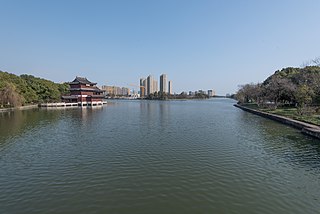
The Eastern Zhejiang Canal is located in Zhejiang province, China. Its west end is in Xixing Street, Binjiang District, Hangzhou City, crossing Cao'e River and Shaoxing City to its east end, the Yong River estuary in Ningbo City. The canal is 239 kilometres (149 mi) long. Early canal construction took place in the Shanyin old canal in Shaoxing City, during the Spring and Autumn period. In the third century AD, an official named He Xun supervised the construction of Xixing Canal, establishing the complete Eastern Zhejiang Canal.

Qianjiang Century City is a central business district under construction, located in Ningwei Street, Xiaoshan District, southeast of Qiantang River, Hangzhou, Zhejiang Province, China. The total planned area is 22.27 square kilometers and the planned population is 160,000. The core area is 9.6 square kilometers.

The White Pagoda Park, or romanised as the Baita Park, is a park in Shangcheng, Hangzhou, Zhejiang, China. The park opened on 1 May 2014. On the north bank of Qiantang River and the south border of the West Lake Scenic Area, the park is part of the Grand Canal National Cultural Park in Hangzhou. Within the park, there are the White Pagoda that can date back to the Five Dynasties and Ten Kingdoms period and the historical relics of the Jianggan-Gongshu Railway, which was opened in 1908 as the first railway in Zhejiang.













